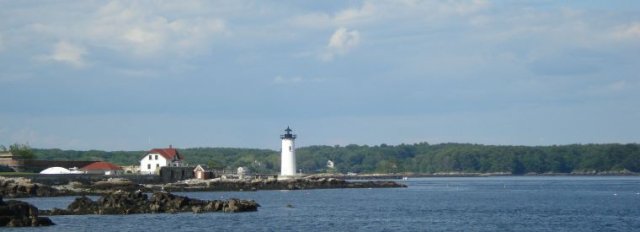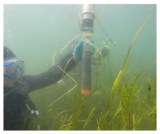EPA Research in New Hampshire
EPA researchers are working hard to protect communities across the nation. Learn about some of the work EPA researchers are doing in New Hampshire.
- Harmful Algal Bloom Detection
- Seagrass for a Changing Climate
- Data to Manage Excess Nutrients
- Simulating Oil Spill Burns to Improve Clean Up and Protect Air Quality
- Innovative Approach to Finding PFAS in the Environment
- Suitable Groundwater Remediation
- Thermal Remediation of Waste Oils
- Helping Community Drinking Water Systems Find Cost-Effective Solutions to Treatment Challenges
For more EPA work, see EPA in New Hampshire.

Harmful Algal Bloom Detection
The Cyanobacteria Assessment Network uses historical and current satellite data to provide an early warning for harmful algal blooms in freshwater. Since 2015, CyAN imagery has detected algal blooms in Ohio, Florida, California, Vermont, New Hampshire, Massachusetts, Connecticut, and Rhode Island before traditional monitoring efforts alerted watershed managers. Read The Cyanobacteria Assessment Network.
Seagrass for a Changing Climate

Seagrass meadows make up a powerful carbon storage system—one that, if properly managed, could help rein in global carbon dioxide emissions responsible for climate change. To get a better picture of how much carbon is stored in seagrass meadows, EPA researchers in New England sampled seagrass and sediments from 11 meadows in the region. Read EPA Scientists Study the Carbon-Storing Power of Seagrass to Fight Climate Change.
Data to Manage Excess Nutrients

Excess nutrients are one of our country’s most widespread and challenging water quality problems. EPA and partners are focused on improving nutrient management by incentivizing the development of low-cost technology solutions such as nutrient sensors. In Durham, New Hampshire, a research team at the University of New Hampshire deployed low-cost nutrient sensors to assess amount and timing of nitrate fluxes through reservoirs. Read Nutrient Sensor Action Challenge Winners: Data and Decisions to Manage Excess Nutrients.
Simulating Oil Spill Burns to Improve Clean Up and Protect Air Quality
Burning oil spills has been a fast and relatively safe way to reduce the impact on water quality and marine life. However, burning oil can impact air quality and the oily residues left behind in the water can cause environmental damage. Several new exploratory methods are being tested by BSEE at the U.S. Army Corps of Engineers Cold Regions Research and Engineering Laboratory in New Hampshire. Read Simulating Oil Spill Burns to Improve Clean Up and Protect Air Quality.
Innovative Approach to Finding PFAS in the Environment
Per- and polyfluoroalkyl substances, known as PFAS, are chemicals used in countless consumer products. With so many types of PFAS in use, it can be difficult to find out which ones are persisting in the environment. EPA researchers in the Office of Research and Development used a new approach, non-targeted analysis, to help communities, including in New Hampshire, determine potential PFAS exposure. Read EPA Researchers Use Innovative Approach to Find PFAS in the Environment.
Suitable Groundwater Remediation
The South Municipal Water Supply Well Superfund Site located in Peterborough, New Hampshire. Due to contaminated groundwater around the site, New Hampshire Department of Environmental Services (NHDES) and EPA Region 1 requested EPA Office of Research and Development (ORD) technical assistance in for information on innovative groundwater remediation technologies, including thermal, enhanced bioremediation, and permeable reactive barrier (PRB) applications. Technology transfer efforts by ORD personnel resulted in recommendations on bench-scale studies, site characterization and monitoring requirements, and implementation of the thermal and PRB remedies.
Thermal Remediation of Waste Oils
The Beede Waste Oil Superfund Site is located in Plaistow, NH within a predominantly residential area. Prior commercial operations at the site included storage and distribution of fuel oil and recycling of used oil. Spills, leaks from storage tanks, and discharges to lagoons on the site created subsurface plumes of light nonaqueous phase liquids that contained a wide variety of petroleum hydrocarbons, polychlorinated biphenyls, and chlorinated solvents. NHDES and EPA Region 1 requested EPA ORD technical assistance to aid in determining if a thermal enhancement to the groundwater extraction system would be required to meet soil cleanup goals, and if so, which of the thermal technologies would be most applicable to this site. In addition, ORD personnel provided technical support on delineation of the area to be treated using thermal remediation.
Helping Community Drinking Water Systems Find Cost-Effective Solutions to Treatment Challenges
Emerging contaminants, such as per- and polyfluoroalkyl substances (PFAS), are challenging to drinking water systems across the country. Effective treatment for emerging contaminants can be unknown, difficult, and extremely costly. Working with the state of New Hampshire, EPA researchers are providing technical assistance to one very small and two large community water systems with PFAS concerns to help them identify optimal, cost-effective treatment methods and optimize the long-term operation of their chosen technology. These efforts will also be used to develop best practices and performance and cost estimate tools so water utilities across the country can make informed treatment and operational choices. Read Technical Assistance for Treatment Options to Remove Emerging Contaminants.
